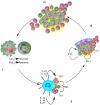Protection versus pathology in tuberculosis: recent insights
- PMID: 22613092
- PMCID: PMC3423558
- DOI: 10.1016/j.coi.2012.04.008
Protection versus pathology in tuberculosis: recent insights
Abstract
Recent studies have revisited the roles of prime players in the immune response to tuberculosis (TB) and have highlighted novel functions of these players. Specifically, immunoregulatory mechanisms mediated by IFNγ have been delineated as well as a novel role for neutrophils in promoting antigen presentation. New insights into the interaction between the bacterium and phagocyte indicate that the bacterium actively promotes phagocyte necrosis rather than apoptosis and that this impacts generation of the acquired response. There are also many new examples of how the phagocyte responds to the bacteria and how it mediates control. The phenotype of protective T cells is also being re-examined. These developments provide promise for improved vaccine design and highlight the complexity of this disease.
Copyright © 2012 Elsevier Ltd. All rights reserved.
Figures

References
-
- Day TA, Koch M, Nouailles G, Jacobsen M, Kosmiadi GA, Miekley D, Kuhlmann S, Jörg S, Gamradt P, Mollenkopf H-J, et al. Secondary lymphoid organs are dispensable for the development of T-cell-mediated immunity during tuberculosis. Eur. J. Immunol. 2010;40:1663–1673. - PubMed
-
-
Robinson R, Khader S, Martino C, Fountain J, Teixeira-Coelho M, Pearl J, Smiley S, Winslow G, Woodland D, Walter M, et al. Mycobacterium tuberculosis infection induces il12rb1 splicing to generate a novel IL-12Rβ1 isoform that enhances DC migration. J. Exp. Med. 2010;207:591–605. This paper highlights a novel function for IL-12Rb1 and an alternative splice variant in migration of DCs from the lung to the DLN
-
Publication types
MeSH terms
Grants and funding
LinkOut - more resources
Full Text Sources
Other Literature Sources
Medical

